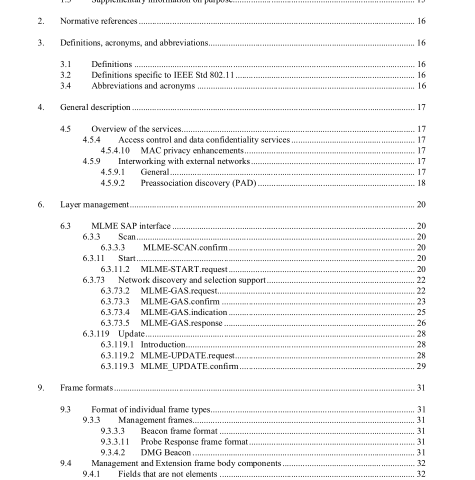IEEE 802.11aq-2018 pdf download.IEEE Standard for Information technology- Telecommunications and information exchange between systems Local and metropolitan area networks- Specific requirements Part 11: Wireless LAN Medium Access Control (MAC) and Physical Layer (PHY) Specifications Amendment 5: Preassociation Discovery
4. General description
4.5 Overview of the services
4.5.4 Access control and data confidentiality services
Insert the following .cubclause (4.5.4.10) after 4.5.4.9:
4.5.4.10 MAC privacy enhancements
When a non-AP STA searches lör, and connects to, an infrastructure I3SS, IBSS. or PI3SS or attenips to discover services on a network prcassociation. it defines the addressing of its MAC layer for the particular connection. If the STA uses a fixed MAC address it is trivial to track the STA. An MSDL1 transmitted by a STA is assigned a sequence number thai ilnever reset, can also be used to track a device irrespective of the MAC address. If OFDM is used, the PHY DATA scrambler used can enable tracking of a device irrespective of the MAC address if it is not reseeded. The dynamic nature of HSS membership combined with this tracking information allows for construction of a network of connections. locations, and behavior. This network can be used to glean private and sensitive infonnation regarding the individual behind the device.
Furthermore, even without establishing a connection, a mobile or portable STA that gratuitously transmits Probe Request frames containing SSIDs of fvorcd infrastructure BSS networks, or announces the existence of hISS networks, can reveal potetitially sensitive information about its location and location history.
To mitigate this sort of traffic analysis a STA can support the ability to periodically and randomly change its MA(’ addresses and reset counters and seeds prior to association. While discovering networks, a STA can refrain from gratuitously transmitting Probe Request frames containing SSIDs of favored BSS networks.
4.5.9 Interworking with external networks
Insert the following subdause heading t’4.5.9.1, and change tile text t’originaling from the former 4.5.9) of the now 4.5.9.1 us shown:
4.5.9.1 General
The intcrworking service allows non-AP STAs to access services provided by an external network according to the subscription or other characteristics of that external network. An IEEE Sid 802.11 non-AP STA might have a subscription relationship with an external network. e.g., with an SSPN.
An overview of the interworking functions addressed in this standard is provided below:
— Network discovery and selection
Discovery of suitable networks through the advertisement of access network type. roaming consortium and venue infonnation, via Management frames
Selection of a suitable IEEE 802.11 infrastructure using advertisement services (e.g.. access network query protocol (ANQP) or art IEEE 802.2 l’ Information Server) in the BSS or in an external network reachable via the KSS.
Selection of an SSPN or external network with its corresponding IEEE 802.11 Infrastructure
Preassociation discovery (PAD)
Discovery of services offered h’ a 1-ISS or an external network reachable via that IISS
Emcrgcncy services
— Emergency Call and Network Alert support at the link level QoS mapping distribution
— SSPN intcrfice service between the AP and the SSPN
The generic advertisement service (GAS), described in 4.5.l(), provides both stpport tbr a STA’s network discovery and selection, and support for a conduit for comniunicalion by a non-AP STA with other information resources in a network before joining the wireless LAN.
The interworking service supports emergency services by providing methods for users to access emergency services via the IEEE 02.ll infrastructure, advertising that emergency services are supported (see 11.25.6) and identifying that a traffic stream is used for emergency services.
The interworking service provides QoS mapping for SSPNs and other external networks. Since each SSPN or other external network might have its own layer-3 end-to-end packet marking practice (e.g., differentiated services code point (DSCP) usage conventions), a means to remap the layer-3 service levels to a common over-the-air service level is necessary. The QoS Map service provides STAs a mapping of network-layer QoS packet marking to over-the-air QoS frame marking (i.e., user priority).
The SSPN Interface service supports service provisioning and transfer of user permissions from the SSPN to the AP. The method and protocol by which these permissions are tmnsferred from the SSPN are outside the scope of this standard
Insert the tollo wing .cubdause (4.5.9.2, including Figure 4-15a and Figure 4-l5b) after 4.5.9.1:
4.5.9.2 Preassociation discovery (PAD)
4.5.9.2.1 Introduction
PAD is an interworking function provided by a BSS to allow a non-AP and non-PCP STA, prior to association, to discover information concerning services that might be available to the STA when it is associated with the BSS. PAl) provides a method for the STA to gather information to aid in the decision to select a BSS with which to associate.
4.5.9.2.2 Architecture
Figure 4-15a and Figure 4-l5b show the functional how of MAC messaging and service information between a service information client (SIC) and a service information registry (SIR). These entities are described in 4.5.9.2.3, 4.5.9.2.4, and 4.5.9.2.5. The active components within the architecture ditrer depending upon whether unsolicited or solicited PAD is being used.IEEE 802.11aq pdf download.IEEE 802.11aq-2018 pdf download
IEEE 802.11aq-2018 pdf download

Leave a Reply